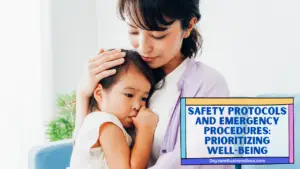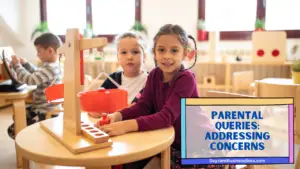Enrolling a child in daycare is an important step for both parents and their children. It’s a step toward development, growth, and a world of new experiences. This change, however, can be accompanied by a mixture of enthusiasm and dread. Parents work hard to ensure that their child is comfortable, safe, and happy in these new surroundings. This is where a carefully crafted daycare orientation checklist comes into play – an invaluable tool that holds the key to a smooth transition into the world of childcare.
The most useful daycare orientation checklist includes a facility tour, staff introduction, schedule overview, safety protocols, emergency procedures, a discussion of the child’s needs, communication guidelines, and parental queries.
In this article, we will go through the elements that make up a childcare orientation checklist. So, join me on this informative journey of discovery as we unearth the value of a careful orientation checklist in ensuring a happy and enriching childcare experience.
Facility Tour: Building Familiarity and Comfort

The crucial facility tour is the first stage in the full daycare orientation process. This critical component establishes the groundwork for a child’s smooth transition into the daycare setting. Parents and their children construct a road towards familiarity and comfort by going on this journey through physical space that will become a vital part of their child’s daily routine.
The fascinating world within the daycare’s walls unfolds before expectant eyes during the facilities tour. Classrooms beckon with bright decorations and educational tools, promising study and growth. Play spaces that have been meticulously developed to inspire imagination and physical activity invite you to have endless fun. Restrooms with child-friendly facilities function as respite and care places.
This visual adventure has a huge impact. The trip functions as a calming salve for youngsters, relieving any anxiety that may arise from the uncertainties of a new situation. The sights and noises they encounter during their adventure sow the seeds of familiarity, making the future days of daycare less intimidating.
This tour provides enormous reassurance to parents at the same time. Seeing personally the safe, structured, and well-equipped environments in which their child will thrive fosters trust in the daycare’s dedication to their child’s well-being. This aspect of the orientation process emphasizes the daycare’s commitment to providing a safe place for their children.
Read more about: Envision, Execute, Educate: Creating a Business Plan for Your Daycare and Preschool
Staff Introduction: Establishing Relationships
The opportunity to meet the daycare personnel is unquestionably a significant point throughout the full daycare orientation. The intricate network of contacts between parents, children, teachers, caretakers, and administrative officials begins to form at this point.
This introduction is more than just a formality; it is the foundation for trust and open channels of communication that will support the daycare experience. When parents and children enter this domain of personalities, they engage in a conversation that goes beyond words. Parents engage on a journey of understanding the hands that will hold and nurture their children as they interact with the caretakers and educators that will shape their child’s days in this new environment.
This meeting is a priceless piece of the puzzle for children. Meeting the people who will accompany them during the day provides a comforting anchor. Putting names on people, understanding the warm smiles that greet them, and sensing the genuine care that these staff members exude all contribute to the creation of a secure cocoon. The formerly alien environment morphs into a haven, with the embrace of trusted caregivers never far away.
On the other hand, parents gain insights that go beyond traditional introductions. They assess the staff’s temperament and professionalism, obtaining a better picture of the instructors who will mold their child’s developmental path. This glimpse into the characters behind the institution provides comfort, allowing parents to imagine the kind hands directing their child’s development.
Schedule Overview: Structuring the Day
Daycare routines emerge as threads of stability in the rich fabric of a child’s early life, weaving a sense of comfort and regularity. During the orientation phase, a full overview of the daily routine unfolds before parents like a roadmap, providing them with insights into the rhythmic cadence that will define their child’s days at daycare.
This orientation’s agenda is more than just a list of activities; it’s a treasure map leading to familiarity and harmony. The schedule incorporates the ebb and flow of meal times, nap periods, energetic moments of play, and stimulating pursuits of learning activities. This detailed snapshot provides parents with a comprehensive idea of how their child’s day will unfold, presenting a vivid image of the experiences that lie ahead.
For parents, this explanation of the daycare routine is a useful tool for planning. Armed with this knowledge, they embark on a two-pronged journey: easing their child’s adjustment and aligning their schedules. The timetable provides a touchstone for daily living, facilitating a smooth transition from the cozy embrace of home to the lively world of daycare. Parents help their child’s sense of security by familiarizing them with the upcoming activities and smoothing the edges of the initial transition phase.
Aside from the child’s comfort, the program also helps parents create their schedules. They build a well-coordinated dance between home and childcare by matching their routines with those of the daycare, reducing any dissonance that may result from competing schedules.
Safety Protocols and Emergency Procedures: Prioritizing Well-Being

The light of safety glows with unrelenting intensity amid the complicated world of daycare. The thorough checklist unfolds as parents enter the orientation process, revealing a tapestry of safety standards and emergency procedures precisely constructed to preserve the well-being of every beautiful child entrusted to their care.
The orientation reveals a range of safety precautions, each thread interlaced to produce a secure atmosphere. Secure entrance systems stand sentinel from the threshold, ensuring that only authorized individuals enter through the gateway, a digital guardian to the refuge within. Intricately created childproofing details weave their way through every aspect of the space, making each area a haven for discovery and curiosity.
Surveillance, like an ever-vigilant sentinel, maintains guard over the playgrounds and corridors, ensuring that every moment spent within these walls is safe. This technological gaze goes beyond ordinary observation; it demonstrates the daycare’s dedication to monitoring.
Equally important, the orientation shines a light on the emergency processes that serve as silent sentinels in the face of unforeseen challenges. Parents are given the keys to effective reaction through these practices, should the unexpected knock on the door. This knowledge is more than a procedure manual; it is a source of comfort, an anchor of confidence in the face of uncertainty. Parents develop the ability to act, defend, and secure their child’s and their classmates’ safety.
Read more about: From Plans to Caring Hands: Kickstarting Your Elderly Daycare
Discussion of the Child’s Needs: Personalized Care
The diversity of each child’s being shines as a constellation of individuality within the vivid fabric of a daycare community. Recognizing that each kid is a universe unto himself or herself, the daycare orientation process welcomes this uniqueness through an important discourse about the child’s requirements.
The fundamental awareness that every child is a mix of preferences, allergies, and requirements is at the heart of this interaction. The orientation checklist expands to include discussions about food restrictions, medical issues, and behavioral quirks. This conversation, like a compass pointing toward empathy, builds a bridge between parents and caregivers, ensuring that the child’s unique needs are not just acknowledged, but woven into the fabric of their care.
Sharing this complex web of information with caregivers is like giving them a treasure map to the child’s heart. Dietary restrictions, whether modest aversions or severe allergies lead to the preparation of delicious and safe meals. Medical issues, from common to remarkable, provide caregivers with insights that affect the child’s daycare experiences, ensuring that every encounter is laced with care and awareness. Behavioral concerns, those delicate strands of individuality, hold the key to cultivating a harmonic connection, a dance of comprehension between caregiver and kid.
Caregivers unroll specialized care like a tailored cloak in the embrace of this information, made to accommodate and enhance each child’s unique path. The orientation checklist transforms from a plain document into a lifeline of comprehension, guaranteeing that the child’s world within the daycare mirrors the contours of their uniqueness.
Communication Guidelines: Bridging the Gap
The solid pillar of good communication, a bridge that binds parents and caregivers in a tapestry of shared understanding, is at the heart of a thriving daycare journey. The necessity of this communication becomes a blazing beacon as the orientation checklist unfolds its wisdom, directing both parties toward a harmonious and meaningful experience.
The various channels that prepare the path for this communication are outlined within this blueprint of orientation. Daily reports, like intimate letters from the world of daycare, provide parents a look into their child’s day – the laughing, the discoveries, the moments of progress. These valued gateways into the daycare cosmos allow parents to see their child’s unfolding experience.
Newsletters, like collective joy whispers, build a tapestry of information, be it updates, events, or educational insights. This community sharing cultivates a sense of belonging, transforming parents into active participants in their child’s larger educational landscape.
Meetings, whether official or informal, arise as sacred meetings in which thoughts and worries are shared, and aspirations and challenges are addressed. These conversations go beyond simply exchanging information; they foster a sense of community, resulting in a united front for the child’s growth and development.
Communication transparency emerges as the foundation of trust. Parents are kept up to date on their child’s activities, progress, and any growing issues, promoting a friendly environment. This peek into the world of daycare fosters not only trust but also the ability for parents to actively participate in ensuring their child’s needs are fulfilled precisely.
Effective communication allows caregivers to go beyond the classroom and grasp the child’s experiences in the comfort of home. This holistic viewpoint is at the heart of a collaborative and supportive setting in which caregivers and parents work together to create a whole ecosystem of growth.
Parental Queries: Addressing Concerns

Within the childcare orientation checklist is a specific place, a type of sanctuary, reserved for parents’ curious minds and anxious hearts. This oasis of opportunity invites parents to share their concerns, questions, and interests – a treasure trove of open communication that fosters a foundation of understanding and confidence.
As the checklist progresses, this venue for parental questions takes center stage, emphasizing the daycare’s dedication to transparency and parent involvement. Parents enter a zone of empowerment here, where no question is too tiny, no concern too unimportant. This interaction becomes a lifeline, constructing a tapestry of information that strengthens parents’ confidence in their daycare decision.
Curious questions regarding the curriculum weave connections between the classroom and the home. Parents explore the learning landscape, uncovering the educational adventures that await their children. Questions concerning the discipline method illuminate the route of behavioral development like lights. Parents uncover the approach that will shape their child’s character and values through engaging in these dialogues.
However, it is typically the smallest aspects that have the most impact – schedule intricacies, nutritional peculiarities, and the intricacy of everyday care. This inquiry space generates a reassurance mosaic, portraying a picture of attentive care in which every aspect of a child’s existence is addressed and accommodated.
The beauty of this relationship rests not only in the exchange of knowledge but also in the development of trust. By responding to parental concerns, the daycare creates an environment in which parents feel respected and understood. They leave these meetings with a renewed sense of being well-informed partners, able to confidently guide their child’s daycare experience.
Read more about: Penny-Wise Marketing: Low-Cost Ways to Boost Your Daycare
Frequently Asked Questions

What is the purpose of including a facilities tour on the daycare orientation checklist?
A facility tour is given to help parents and children become acquainted with the daycare environment. It alleviates anxiety by offering a visual representation of the classrooms, play areas, and other regions. This early encounter provides both parents and children with a sense of comfort and reassurance, establishing the tone for the childcare experience.
How does talking about a child’s needs affect their childcare experience?
During orientation, caregivers can provide tailored care by discussing a child’s needs. Dietary preferences, medical concerns, allergies, or behavioral considerations may all be involved. Parents who share this knowledge ensure that their child’s particular needs are satisfied, boosting their well-being and establishing a loving environment.
What is the significance of communication guidelines in the orientation checklist?
Communication principles help parents and caregivers form a strong connection. Parents are kept informed about their child’s progress and activities through transparent and regular communication channels such as daily reports, newsletters, and meetings. It also enables caregivers to gain a deeper understanding of the child’s home experiences, allowing for a more collaborative approach to the child’s care and development.
To learn more on how to start your own daycare checkout my startup documents here.
The information provided by DaycareBusinessBoss.com (“The Site”) is for general informational purposes only. All information on the Site is provided in good faith, however, we make no representation or warranty of any kind, express or implied, regarding the accuracy, adequacy, validity, reliability, availability or completeness of any information on the Site. Under no circumstance shall we have any liability to you for any loss or damage of any kind incurred as a result of the use of the Site or Reliance on any information provided on the Site. Your use of the Site and your reliance on any information on the Site is solely at your own risk.
This blog post is for educational purposes only and does not constitute legal advice. Please consult a legal expert to address your specific needs. Terms and Conditions. (https://daycarebusinessboss.com/terms-conditions/)

Meet Shawn Chun: Entrepreneur and Childcare Business Fan.
I’m a happy individual who happens to be an entrepreneur. I have owned several types of businesses in my life from a coffee shop to an import and export business to an online review business plus a few more and now I create online daycare business resources for those interested in starting new ventures. It’s demanding work but I love it. I do it for those passionate about their business and their goals. That’s why when I meet a childcare business owner, I see myself. I know how hard the struggle is to retain clients, find good employees and keep the business growing all while trying to stay competitive.
That’s why I created Daycare Business Boss: I want to help childcare business owners like you build a thriving business that brings you endless joy and supports your ideal lifestyle.


